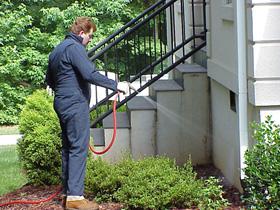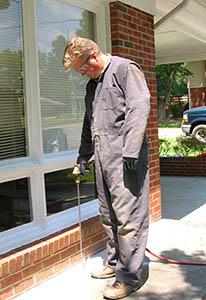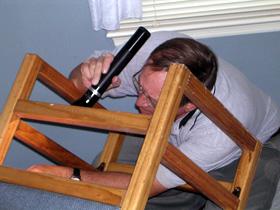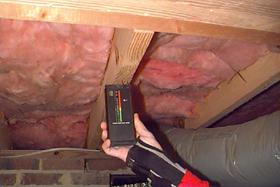Why Hire a Pest Control Professional?
People vary in their tolerance for arthropod pests that periodically, or habitually, invade our homes and cause some level of discomfort. The need for monthly, quarterly or yearly pest control services is a matter of your personal preference and your perception of what is (and is not) a problem. Ultimately, deciding whether you need professional pest control service boils down to your definition of a "pest" and your tolerance for pest encounters.
Although you may prefer a "do-it-yourself" approach to pest control, there are situations where the job is best left in the hands of a pest management professional (PMP). This is particularly true with wood-destroying insects such as termites, carpenter ants, and wood-boring beetles. Professionals may also be more equipped to deal with public health pests such as bed bugs, mosquitoes, and stinging pests (fire ants, hornets, etc.). Treatments for these pests can be complex and expensive depending upon the extent of the problem. We cannot endorse specific pest control companies, but we can offer some tips to help you reach an informed decision on the type of service you need or want. The emphasis here is on solving specific problems, particularly for wood-destroying pests, but the same general principles apply to regular service contracts for other common household pests like cockroaches and ants. Becoming an informed, educated consumer is the best way to protect yourself and to make sure you get the service(s) you need and want. Here are some issues to consider when hiring a PMP.

Perimeter treatments might be part of your service contract, where you receive pest control treatments on a scheduled basis. You and your technician should discuss whether you might like a service contract to prevent pest activity, or whether you prefer to treat pests reactively (only when you see them). The type of service you choose is up to you alone.
M. Waldvogel - NCSU - Entomology & Plant Pathology
North Carolina Structural Pest Control Regulations
In North Carolina, anyone who performs structural pest control (SPC) for the general public (i.e., not on their own property or their employer's property) must be licensed by the Structural Pest Control and Pesticides Division of the North Carolina Department of Agriculture & Consumer Services - Structural Pests Control & Pesticides Division (SPCPD). There are three phases or types of licenses based on the type of work or pest involved:
- P-phase: Covers household pest control (cockroaches, ants, spiders, etc.) both indoors and outside. P-phase also includes vertebrates such as mice and rats.
- W-phase: Covers wood-destroying pests (such as termites, powderpost beetles, etc.) Individuals with W-phase licenses also perform WDIRs (the so-called "termite inspections" for residences being sold).
- F-phase: Covers pests in both the P and W phases, but it specifically involves the use of a fumigant. Please note that a fumigant is not the same thing as a fogger ("bug bombs") that you can buy in many retail stores. Fumigation involves the use of special, highly toxic gasses that are released into structures that have been completely sealed or enclosed under a tarpaulin.
The removal or exclusion of vertebrate animals, such as snakes, raccoons and bats from houses is usually done by wildlife damage control agents (WDCAs). However, WDCA's cannot apply pesticides (e.g, to get rid of fleas that may be the result of a raccoon or oppossum in the house) without proper licensing. Many WDCAs work for pest control companies or they are licensed in structural pest control so they can perform any necessary insecticide treatments.
In North Carolina, all pest control companies must have at least one licensed individual (licensee) on their staff. The other employees work under that licensee's supervision. Details about these categories can be found at the NCDA&CS website. License numbers have 3-4 digits followed by letters that designate which phases or types of pest control the company employees are allowed to perform. For example, a company (licensee) with a license number "9999PWF" is able to provide all phases pest control services. On the other hand, a company with the license number "9999P" can perform pest control for household pests (such as those mentioned above), but they cannot perform any treatments for termites or other wood-destroying pests, even if the treatments are applied indoors, rather than to the soil. Make sure that the company with whom you deal has a valid license issued by the NCDA&CS to provide the service you need. All employees of the company who sell pest control contracts or perform pest control services must have an identification card issued by the NCDA&CS. This card will have their employer's SPC license number on it. Under NCDA&CS rules, the company's name or its SPC license number must be displayed on both sides of every service vehicle, too. Vehicles used strictly by company sales representatives are not required to carry these markings, although most companies do as a form of advertising. Whether or not the vehicle is marked, ask to see the person's identification card as proof of his/her employment with an authorized pest control company. If he/she cannot produce a valid identification card, you should contact the NCDA&CS.
Some companies have separate sales and technical staff. Salespeople do not provide your pest control treatment. You should feel free to ask if the individual assessing your pest problem is a technician or a salesperson for the company, or if they are a salaried employee or are paid partially on a commission basis. This does not imply that salaried employees are more truthful or more accurate than those working on a commission basis. Asking questions simply shows that you expect to be treated professionally.

The pest management solution(s) proposed should address the problems you have, period. Here, the technician is treating the soil beneath a slab to control termites. This is an important step for a termite treatment, but would be useless for mosquitoes- for instance. Be sure you are getting a service that addresses your wants and needs.
M. Waldvogel - NCSU - Entomology & Plant Pathology
Pesticides Are Not the Only Answer to a Pest Problem
Pesticides are not always the answer.
Some pesticide treatments are done routinely (e.g., quarterly, annually, etc.) to prevent pest activity, regardless of whether or not there actually is a problem that needs control. This typically involves the application of a residual (long-lasting) pesticide as part of treatment. However, specific, non-routine pest problems are not always solved by simply applying a pesticide. Effective pest control starts with a thorough inspection. Then if necessary, a pesticide can be applied. A thorough initial inspection will help you to determine IF a pesticide is the best choice for a particular situation and then where to direct any pesticide applications so that it will be most effective and least hazardous to you, your family and the environment. In most cases, an integrated pest management strategy is best. This means using multiple tactics to control a pest infestation. Many viable solutions to pest problems do not involve applying a pesticide at all. Thus, when dealing with a pest problem, you should start by answering the following questions:
- What is causing the problem? (Identify the pest)
- How many pests are seen? How often are they seen? (Monitor pest activity)
- Where are the pests being found? Is there something attracting the pest to the area?
- Are they entering the house from outdoors? If so, how are they getting indoors? Did it "hitchhike" or crawl/fly indoors?
- What steps do I need to take in order to correct the current situation and prevent it from ocurring again? (Take action using all control strategies available and reasonable)
Most insect pests are simply nuisances or cause minor problems that can be ignored until they disappear or else can be corrected by vacuuming them up or cutting off their entry/access points (exclusion). Other pests, such as those that attack stored foods and other products, can often be eliminated by simply discarding the infested item(s) and cleaning the storage area thoroughly (sanitation). Many people expect pesticides to i) be the best solution to a pest problem and, ii) eliminate all of the pests quickly. This is simply not the case, especially the latter. Some pesticides, particularly baits, work slowly (but effectively) by design. Also, weather is a major factor in the effectiveness of pesticide applications. Hot dry weather often promotes invasions of pests such as springtails and millipedes and can also make pesticide applications less effective. You need to be reasonably patient to allow any chemical control measures to take effect before you do additional spraying. In addition, you should be open to non-chemical strategies that can be just as, if not more effective than, pesticide application (e.g., reducing sources of moisture that support millipede activity and reproduction).

Inspection is the most critical part of an integrated pest management plan. A pest management professional should conduct a thorough visual inspection of your property before proposing treatment. Here, you can see inspection of a chair for bed bug activity.
M. Waldvogel - NCSU - Entomology & Plant Pathology
Hiring a PMP for Pest Control
1. Don't be rushed into making a decision.
Termites and other wood-destroying insects can cause significant damage if they are not controlled. However, that doesn't mean you need to rush your decision about how to solve the problem. With termite contracts, the pest control company must give you three days over which you may decide to cancel the treatment. It is better to spend a few extra days evaluating the safest, most effective and economical solution. You may also use this time to collect more bids (three are recommended). A delay of even several weeks is really of no real consequence in terms of additional termite damage. If your floor was going to collapse from termite damage, it would likely do so regardless of the additional time (and you likely needed the repairs anyway). With pests such as wood-boring beetles, treatments like fumigation are effective but can be very expensive (in excess of $10,000). For that reason, it's important to make sure that the infestation active AND spread throughout the house. It does not hurt to have more than one company assess your situation and offer competitive solutions.
2. Understand the problem.
Make sure that the nature of the pest problem is clearly explained to you (or get this information on your own from reputable online sources). You may also work your local county Cooperative Extension Center, or an Extension Specialist at NCSU. In the case of termites or other wood-destroying insects, any proposal/contract to treat your house must include a detailed building diagram that describes the problem. The diagram should specify the location and nature of the problem (e.g., damage, termite tubes and/or live termites or other pests). In particular, keep in mind the following points:
- There is a difference between finding termites and finding "conditions conducive to termite infestations." Both situations need your attention, but usually in different ways. Eliminating conditions favorable to wood-destroying pests, mostly moisture-related problems, usually means engaging in repairs or alterations to the crawlspace or other parts of the house or the area around it. Check Termites - Preventing Problems in Existing Homes for more information about what to look for around your home that may create conditions conducive to termite problems.
- Any evidence of wood-boring beetles or termite activity should be described to you clearly. More importantly, ask if the evidence indicates if the infestation appears to be active or inactive. It is difficult (nearly impossible) to determine the age of termite damage simply by looking at the wood. Claims that an infestation is active must be supported by visible evidence. Don't accept a conclusion of "suspected" termite activity. If the evidence is inconclusive, collect a sample of the insects and/or damage and bring it to your local county Cooperative Extension center. If necessary, your county cooperative extension agent can arrange to have the sample examined by a specialist at NCSU. If it is impossible to collect a sample, contact the North Carolina Department of Agriculture & Consumer Services (NCDA&CS) and arrange for a state inspector to examine the damage.
- Knowing the moisture content of the wood is particularly helpful for problems with wood-boring beetle and wood-decaying fungi. Wood moisture content can only be determined using a moisture meter. Make sure that enough readings are collected so as to be truly representative of the area of concern. High wood-moisture readings (i.e., readings above 20%) in crawlspaces, attics or exterior walls of log homes could indicate problems other than simply insects. Mold/mildew growing on wood is a sign of excess moisture or high humidity, but not necessarily an indication that wood-rotting fungi are present. Correct these problems as you deal with any insect infestation.
- Do not accept costly services without proof that you have a problem. This is especially important for pests such as bed bugs, which can be very expensive to treat. The pest management professional should be able to show you a live specimen obtained from your dwelling before engaging in any sort of treatment. In fact, except for preventative services, this should be standard for any household pest control treatment. Pesticides should not be applied reactively until a positive identification of the target pest is obtained.
- A professional should be able to explain to you not only what the problem is and how severe, but also how the treatment will solve your problem. If you are not comfortable with their explanation, ask more questions until you feel confident that you understand how the issue will be solved, and how long the process will be. Be aware that you may be asked to participate in the treatment. For instance, the technician may ask you to bag items prior to a bed bug treatment. They may ask you to cover or remove some sorts of food from your kitchen before a cockroach treatment, etc. Understand your role in solving your pest control problem and be aware of potential treatment failures associated with a lack of adherence to the contract and plan developed by you and the pest control company. If you are expected to engage in activities spelled out in a contract and you refuse, the technician may be unable to complete the treatment, or the contract may be voided.
3. How severe is the damage/problem?
In some cases, you can easily see pest damage. For instance, for wood-attacking pests, you might see that wood is severely damaged and must be repaired or replaced. Particularly for wood-boring beetles, you probably will not see the true extent of any damage just by a simple visual inspection of the wood. One quick and simple (but not entirely accurate) test is to poke or probe the wood with a ice-pick, rock-hammer or other sharp tool. If the tool easily penetrates the wood and/or the wood splinters, then you may probably need to consult with a contractor or engineer who can determine if the damage is structurally signficant (i.e., could lead to structural failure of that wood). In the long run, it may be just as practical (and economical) to replace or brace wood that is damaged. In the case of other pest infestations, you may see extensive signs of activity: fecal spotting for bed bugs and cockroaches, turf damage for fire ants and other lawn pests, or you may experience an excessive number of bites from pesky mosquitoes. If damage or pest activity is not inherently obvious to you, the pest management professional should be able to visually show and/or explain to you the extent of your problem either after an inspection, or, after pest monitoring (tracking the number of pests present over time). Approaches to the problem and cost of treatment may differ depending on the severity of infestation.
4. Work with the PMP to understand the treatment and your role.
As mentioned above, you may be expected to participate in your pest management service. This may include reducing clutter, removing debris, or working to eliminate conditions conducive to pest activity (moisture, waste, food, etc.). For example, removing cellulose debris from a crawlspace is important and is required as part of a termite treatment. This debris usually consists of scrap pieces of lumber, but it can include paper and other cellulose-containing products large enough to rake up. Many people use their crawlspace as extra storage and place cardboard boxes directly on the soil. If you are going to store items in the crawlspace, make sure you place them on top of plastic sheeting or bricks to keep them off the soil. If you are paying for a termite treatment, the PMP is ultimately responsible for removing the debris either by doing so themselves, or, by making you aware that debris should be removed. The protocol is similar for other intensive pest treatments. Your role in ensuring a successful outcome should be spelled out for you and if you are uncomfortable with the extent of your involvement, make sure this is communicated to the PMP so that compromises can be made. Sometimes the PMP can take on some of the additonal labor, but it may come at an increased service cost.
5. Read your service contract/agreement carefully.
This section predomintly describes a termite contract, but this is true of any pest control service agreement. Before signing any paperwork, read it thoroughly and have it explained carefully. A written proposal is required prior to any ongoing pest control work or for treatments involving termites and other wood-destroying insects. The services to be performed must be outlined. Don't settle for a contract that is vague, or simply says something like "termite treatment". Except when using termite baits, a proper termite treatment usually requires trenching and treating of the soil along both sides of the foundation (including piers and other masonry supports in the crawlspace). Regulations also require that the section of the foundation where termites were found, plus concrete slabs attached to the foundation (such as garages and porches) must be drilled and treated. These steps should be explained specifically. The proposal/contract should also specify the name, concentration and approximate amount of the insecticide that will be used. For non-termite accounts, the PMP should still explain (verbailly or in writing) to you exactly where treatments will be occuring, how often, what pesticide will be used, and how much. If other methods will be applied (non-chemical) they should be explicitly described as well. If your pest control issue requires a short-term solution, you and the technician may decide to move forward without a written agreement, which is fine! However, companies should be willing to draw up paperwork for a treatment if you want the agreements and warranty in writing, even if the service is short-term. A written and signed agreement protects you, and the company.
For termite treatments, whenever possible, a termite-infested structure should be treated completely according to the rules set by the NCDA&CS and by the instructions specified on the pesticide label. In North Carolina, any deviations from these guidelines requires that you (the owner/customer) sign a waiver form acknowledging that all treatment specifications are not being followed. A waiver may be needed because there is situation that limits or prevents a complete standard treatment. For example:
- The crawlspace is too low to allow adequate access to areas that need to be treated.
- The treatment requires indoor drilling that you may not want done because of cost, inconvenience or potential damage to expensive tile or flooring or because of HVAC ductwork in the slab. This situation most likely would occur with slab construction, where the floor covering must be drilled or removed order to drill the underlying slab and treat the soil beneath it.
- When there is a well or cistern under or attached to the house (consult the publication Termites - Treatments Near Wells and Drains)
The pest control operator may suggest that you do not need a complete treatment, but ultimately, the decision of how you want the house treated is yours. Ask these questions and make sure you understand completely:
- What type of treatment is being done?
- Will this treatment protect my entire house?
- What type of my warranty do I get
- What does he contract cover if I find termites in my home?
As a smart consumer, you should contact 2-3 companies and compare the services and guarantees that they offer, as well as the cost. This goes for ANY pest control treatment.
For more information re: termites specifically, visit the NCDA&CS's website Homeowner's guide to Termite Control Service Agreements and Warranties.

If you suspect or are told there is a moisture problem in your crawlspace, make sure that wood-moisture levels are measured with a meter. The readings need to be collected from areas throughout the crawlspace to get a better picture of overall conditions. Steps like this taken by a pest control company reflect reputability.
M. Waldvogel - NCSU - Entomology & Plant Pathology
Summary
Communication is important!
Sometimes, you cannot fix a pest problem on your own. This means you have to have a consultation and conversation with another individual, preferably a pest control expert! Good communication with your pest control company helps prevent misunderstandings and treatment failure. The pest control professional servicing your home should consider you to be a valued customer and they should want to help you and answer all of your questions. Never hesitate to ask questions about the service you are receiving, the chemicals being used in and around your home, or to get advice about what you should be doing to help keep insect problems from occurring again. If you have a problem with some aspect of your service, call the company and talk to a supervisor. A good business wants to know when a customer is not satisfied so they can correct the problem and provide the type of service you want and expect. Be sure to be reasonable. If you are not holding up your end of the bargain, this should be communicated as well. The technician should be aware of any issues you are having executing any part of your agreement so that they can troubleshoot and reassess how to successfully move forward.
Remember: BEFORE you sign...
-
Just as we get second opinions for serious medical problems, you should have 2-3 pest control companies assess the pest problem in your home and present their findings. They should be able to clearly communicate their plan to correct any problems found. Ideally, the technician will offer suggestions beyond pesticide application.
-
In general, compare proposals for the following:
- Treatment specifications
- Cost of the treatment
- Warranties and guarantees
- With termite treatments, compare the following points:
- Any waivers for work that will not be done. Are other companies including or excluding that work in their proposals?
- The cost of an annual renewal on the contract (usually for termites and for some other wood-damaging insects).
- The type of warranty being offered (damage repair versus re-treatment only).
Contact your local N.C. Cooperative Extension center for additional information about various pests. If you have a problem with the service that you are offered or currently receiving, contact the N.C. Department of Agriculture & Consumer Services - Structural Pest Control and Pesticides Division (919-733-6100).
Thank you to Michael Waldvogel and Patty Alder for creating the first version of this document.
Publication date: Dec. 26, 2017
Reviewed/Revised: Jan. 29, 2023
N.C. Cooperative Extension prohibits discrimination and harassment regardless of age, color, disability, family and marital status, gender identity, national origin, political beliefs, race, religion, sex (including pregnancy), sexual orientation and veteran status.

